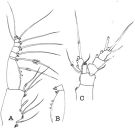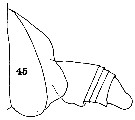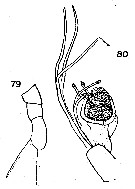|
|
 |
Fiche d'espèce de Copépode |
|
|
Calanoida ( Ordre ) |
|
|
|
Clausocalanoidea ( Superfamille ) |
|
|
|
Scolecitrichidae ( Famille ) |
|
|
|
Scopalatum ( Genre ) |
|
|
| |
Scopalatum vorax (Esterly, 1911) (F) | |
| | | | | | | Syn.: | Scolecithrix vorax Esterly, 1911 (p.327, Descr.F, figs.F);
Scolecithricella vorax : Sewell, 1948 (p.557, 563);
Amallothrix vorax : Brodsky, 1950 (1967) (p.265, figs.F);
? Amallophora smithae Grice, 1962 (p.205, figs.F);
Amallophora vorax : Davis, 1949 (p.39, figs.F, Rem.); Fleminger, 1967 a (p.XII: tabl.1); Bradford, 1973 (p.145) | | | | Ref.: | | | Roe, 1975 (p.336, Rem.); Bradford & al., 1983 (p.114); Ferrari & Steinberg, 1993 (p.469, figs.F, juv., N); Ferrari & Dahms, 2007 (p.66, 68, Rem., as Scopelatum) |  issued from : F.D. Ferrari & D.K. Steinberg in Proc. Biol. Soc. Washington, 1993, 106 (3). [p.470, Fig.1]. Female (from NE Pacif.: Monterey Bay): A, habitus (lateral left side); B, urosome (lateral left side); C, genital segment with attaced spermatophore (lateral left side); D, caudal ramus (dorsal); E, labrum and labium (lateral); F, P5 (posterior); G, unusual P5 (posterior); H, rostrum (lateral). bars: 1 = 1.0 mm for A; 2 = 0.1 mm for B-D; 3 = 0.1 mm for E-G.
|
 issued from : F.D. Ferrari & D.K. Steinberg in Proc. Biol. Soc. Washington, 1993, 106 (3). [p.471, Fig.2]. Female: A, A1 (segments 1-8); B, idem (segments 9-14); C, idem (segments 15-18); D, idem (segments 19-23); E, terminal setae of last segment of A1; F, P2 (posterior); arrow to exopodal segment 3 (anterior); G, P3 (posterior); H, P4 (posterior). Bar: 0.2 mm; letters on proximal segment of A-D
|
 issued from : F.D. Ferrari & D.K. Steinberg in Proc. Biol. Soc. Washington, 1993, 106 (3). [p.472, Fig.3]. Female: A, A2; B, examples of lateral setae on subterminal (left) and apical setae (right) segment of A2; C, Md (gnathobase); D, Md (mandibular palp); E, Mx1 (anterior); F, Mx1 (lateral lobe, with posterior setae darkened); G, Mx2 (coxa); H, idem (basis); I, idem (exopod).
|
 issued from : F.D. Ferrari & D.K. Steinberg in Proc. Biol. Soc. Washington, 1993, 106 (3). [p.473, Fig.4]. Female: A, Mxp (anterior); B, idem (basis, posterior); C, P1 (anterior).
|
 issue from : C.O. Esterly in Univ. Calif. Publs Zool., 1911, 6 (14). [Pl.27, Figs.15, 21]. As Scolecithrix vorax. Female (from San Diego Region; from vertical haul: 0-100 m)): 15, forehead (lateral); 21, habitus (lateral). Nota: Rostrum bifid, the prongs being stout, long and somewhat divergent. Cephalothorax 5-segmented and six and one-half times as long as the urosome. Abdomen 4-segmented. Genital segment more than twice the length of the others together; 2nd and 3 rd segments are of equal lengths and the anal is longer than the preceeding one. A1 23-segmented, do not reach back to the 1st thoracic segment. Exopod of A2 one and one-half times as long as the endopod and the bristles are very long and richly plumose.
|
 issue from : C.O. Esterly in Univ. Calif. Publs Zool., 1911, 6 (14). [Pl.29, Fig.45]. As Scolecithrix vorax. Female: 45, last two thoracic segments and urosome.
|
 issue from : C.O. Esterly in Univ. Calif. Publs Zool., 1911, 6 (14). [Pl.30,, Fig.68]. As Scolecithrix vorax. Female: 68, sensory appendages on Mx2. Nota: Mx2 with 8 appendages: 3 vermiform, end in daisy-like expansions, and the other one is relatively of enormous size and terminates in a set of structures like tentacles; there is a central core in the larger appendage (not shown in the figure) that is surrounded by the tentacles. The 4 smaller flower-like appendages seem to have a similar structure.
|
 issue from : C.O. Esterly in Univ. Calif. Publs Zool., 1911, 6 (14). [Pl.31, Figs.93, 96, 99]. As Scolecithrix vorax. Female: 93P2; 96, P5; 99, a part of the terminal bristle of the exopod of P2. Nota: P5 with 2 segments, the end segment with 2 heavy spines of which the outer is the shorter.
|
 issued from : C.C. Davis in Univ. Wash. Publs Biol., 1949, n. ser. 14. [Pl.6, Figs.79-80]. As Amallophora vorax. Female (from NE Pacific): 79, P5; 80, sensory appendages of apical lobe of Mx2. Nota : Head and 1st thoracic segment fused, 4th and 5th segments fused (Esterly reports the 4th and 5th segments separate). Posterior corners of prosome rounded. Urosome very short, 1/5 the length of metasome (in Esterly as six and one half times the length of the urosome). Genital segment slightly longer than the three following segments combined. A1 23-segmented, do not reach to the posterior border of prosome. Mx2 with 3 vermiform appendages, 4 appendagges with ciliated terminal swellings, and 1 of enormous flower-like sensory appendage. P5 small, and although they are 3-segmented, the 2nd and 3rd segments partly fused (Esterly says they are 2-segmented). Rem : The specimen agrees very closely with Esterly (1911), except that he reports the 4th and 5th thoracic segments of his species to be separate ; he also reports the urosome to be shorter in proportion to the metasome ; his specimen is also smaller (1.6 mm) ; P5 shows no trace of a division line between segments 2 and 3.
| | | | | Ref. compl.: | | | Deevey & Brooks, 1977 (p.256, tab.2, Station "S"); Steinberg & al., 1994 (p.1606); in CalCOFI regional list (MDO, Nov. 2013; M. Ohman, comm. pers.); Sano & al., 2013 (p.11, Rem.: p.22) | | | | NZ: | 3 | | |
|
Carte de distribution de Scopalatum vorax par zones géographiques
|
| | |  Carte de 1996 Carte de 1996 | |
| | | | Loc: | | | NE Pacif. (off San Diego, Monterey Bay), Pacif. (E equatorial), NW Atlant. ( Sargasso Sea, off Bermuda: Station ‘’ S’’ (32°10’N, 64°30’W) | | | | N: | 6 | | | | Lg.: | | | (59) F: 2,4; (143) F: 1,6; (535) F: 2,93-2,64; {F: 1,60-2,93} | | | | Rem.: | bathypélagique.
Si l'identification faite par de Deevey & Brooks (1977) est correcte, nous sommes probablement en présence d'un cas d'isolement consécutif à la fermeture de l'Isthme de Panama.
Voir aussi les remarques en anglais | | | Dernière mise à jour : 31/01/2015 | |
|
|
 Toute utilisation de ce site pour une publication sera mentionnée avec la référence suivante : Toute utilisation de ce site pour une publication sera mentionnée avec la référence suivante :
Razouls C., Desreumaux N., Kouwenberg J. et de Bovée F., 2005-2025. - Biodiversité des Copépodes planctoniques marins (morphologie, répartition géographique et données biologiques). Sorbonne Université, CNRS. Disponible sur http://copepodes.obs-banyuls.fr [Accédé le 23 août 2025] © copyright 2005-2025 Sorbonne Université, CNRS
|
|
 |
 |











